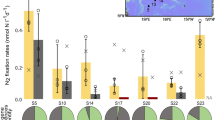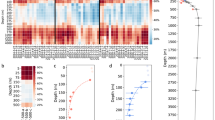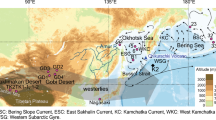Abstract
Barite particles 0.5–5 μm in size are ubiquitous in the ocean and their formation, sinking and dissolution is a major part of the marine barium cycle1,2. Barite formation appears to be caused by biological activity in the upper water column, but the exact mechanism is unknown. Analysis of 1–53 μm and >53 μm sized particles obtained by large volume in situ filtration in the Atlantic suggests that barites are formed in the >53 fxm fraction in near-surface waters and released into the 1–53 μm fraction at depths below the euphotic zone. Scanning electron microscopy and energy dispersive X-ray fluorescence analysis of both size fractions shows first, that barites are formed almost exclusively in microenvironments containing decaying organic matter and the remains of siliceous plankton, and second that barites do not appear to be actively formed by the planktonic organism sampled. This explains the origin of suspended barite, and the similarity of dissolved Si and Ba distributions in the ocean. Suspended and sedimented barite may indicate the intensity of organic matter regeneration in the water column.
This is a preview of subscription content, access via your institution
Access options
Subscribe to this journal
Receive 51 print issues and online access
$199.00 per year
only $3.90 per issue
Buy this article
- Purchase on Springer Link
- Instant access to full article PDF
Prices may be subject to local taxes which are calculated during checkout
Similar content being viewed by others
References
Dehairs, F., Chesselet, R. & Jedwab, J. Earth planet. Sci. Lett. 49, 528–550 (1980).
Collier, R. W. & Edmond, J. M. Prog. Oceanogr. 13, 113–199 (1984).
Chow, T. J. & Goldberg, E. D. Geochim. cosmochim. acta 20, 192–198 (1960).
Wolgemuth, K. & Broecker, W. S. Earth planet. Sci. Lett. 8, 372–378 (1970).
Chan, L. H. et al. Earth planet. Sci. Lett. 32, 258–267 (1976).
Chah, L. H., Drummond, D. & Edmond, J. M. Deep Sea Res. 24, 613–649 (1977).
Revelle, R. R., Bramlette, M., Arrhenius, G. & Goldberg, E. D. Geol. Soc. Am. Bull. 62, 221–236 (1955).
Goldberg, E. D. & Arrhenius, G. O. S. Geochim. cosmochim. acta 13, 153–212 (1958).
Arrhenius, G. O. S. & Bonatti, E. Progr. Oceanogr. 3, 7–22 (1965).
Dymond, J. Trans. Am. geophys. Un. 66, 1275 (1985).
Schmitz, B. Paleoceanogr. 2, 63–77 (1987).
Church, T. M. & Wolgemuth, K. Earth planet. Sci. Lett. 15, 35–44 (1972).
Vinogradova, Z. A. & Koval'skiy, V. V. Dokl. Akad. Nauk. SSSR 147, 217–219 (1962).
Brongersma-Sanders, M. K. Ned. Akad. Wet. Proc. B70, 93–99 (1966).
Li, Y. H. & Chan, L. H. Earth planet. Sci. Lett. 43, 343–350 (1979).
Martin, J. H. & Knauer, G. A. Geochim. cosmochim. acta 37, 1639–1653 (1973).
Dehairs, F., Lambert, C. E., Chesselet, R. & Risler, N. Biogeochemistry 4, 119–139 (1987).
Tendal, O. S. Galethea Rep. 12, 8–99 (1972).
Findlay, B. J., Hetherington, N. B. & Davison, W. Geochim. cosmochim. acta 47, 1325–1329 (1983).
Rieder, N., Ott, H. A., Pfundstein, P. & Schoch, R. J. Protozool. 29, 15–18 (1982).
Bishop, J. K. B., Schupack, D., Sherrell, R. M. & Conte, M. H. in Mapping Strategies in Chemical Oceanography (ed. Zirino, A.) 155–176 (Am. Chem. Soc., Washington DC, 1985).
Bishop, J. K. B. & Fleisher, M. Q. F. Geochim. cosmochim. acta 50, 2807–2826 (1987).
Bishop, J. K. B. & Edmond, J. M. J. mar. Res. 34, 181–198 (1976).
Gardner, W. D. Limnol. Oceanogr. 22, 764–768 (1977).
Kurz, M. D., Edmond, J. M. & Bishop, J. K. B. Trans. Am. geophys. Un. 58, 1171 (1977).
Bishop, J. K. B., Ketten, D. R. & Edmond, J. M. Deep Sea Res. 25, 1121–1161 (1978).
Alldredge, A. L. & Youngbluth, M. J. Deep Sea Res. 32, 1445–1456 (1985).
Author information
Authors and Affiliations
Rights and permissions
About this article
Cite this article
Bishop, J. The barite-opal-organic carbon association in oceanic particulate matter. Nature 332, 341–343 (1988). https://doi.org/10.1038/332341a0
Received:
Accepted:
Issue Date:
DOI: https://doi.org/10.1038/332341a0
This article is cited by
-
Mineralogy, geochemistry, and stable isotope characteristics of Paleozoic carbonate-hosted vein-type barite deposits from Silifke–Mersin, Southern Türkiye
Carbonates and Evaporites (2024)
-
The Origin and Preservation of Suspended Barites near the 90°E Ridge in the Northeastern Indian Ocean
Journal of Ocean University of China (2023)
-
Metals in seston from Cabo Frio Bay, a region under the influence of upwelling in SE–Brazil
BioMetals (2023)
-
Insights into the deglacial variability of phytoplankton community structure in the eastern equatorial Pacific Ocean using [231Pa/230Th]xs and opal-carbonate fluxes
Scientific Reports (2022)
-
Contribution of invasive bivalves (Dreissena spp.) to element distribution: phase interaction, regional and seasonal comparison in a large shallow lake
Biogeochemistry (2022)
Comments
By submitting a comment you agree to abide by our Terms and Community Guidelines. If you find something abusive or that does not comply with our terms or guidelines please flag it as inappropriate.



